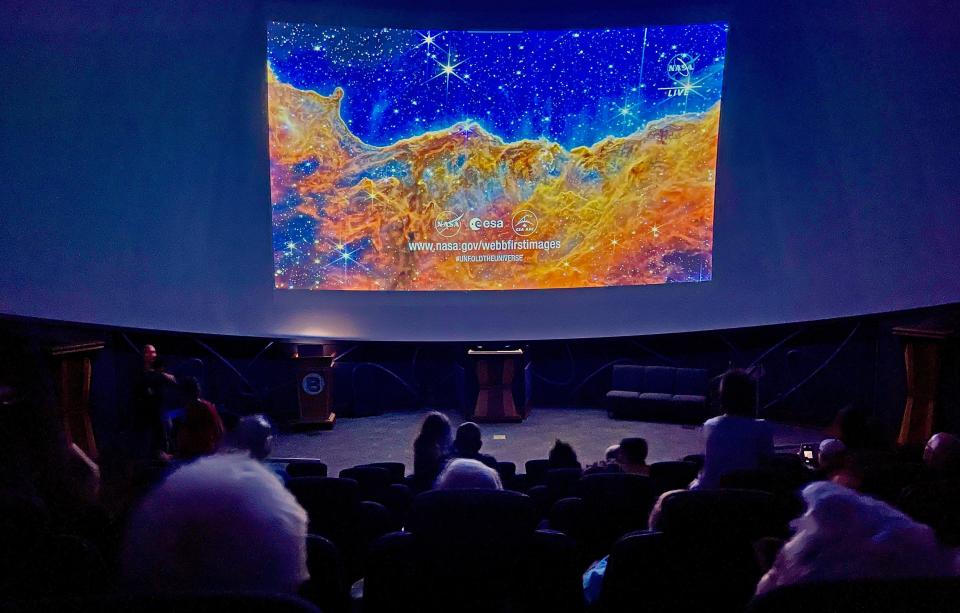'A promising step:' NASA says planet 8.6 times bigger than Earth could support life

NASA's James Webb Space Telescope has uncovered evidence of a possible ocean world larger than Earth with conditions that have the potential to support life.
The exoplanet known as K2-18 b was first discovered in 2015 more than 120 light-years from Earth during the space agency's K2 mission. But Webb's enhanced technology compared to previous space telescopes recently allowed scientists to more closely examine the star-orbiting planet beyond our solar system.
And what they found was nothing short of remarkable.
Observations in 2019 with Webb's predecessor, the Hubble Space Telescope, previously indicated that the exoplanet — 8.6 times bigger than Earth — could be a "Hycean" world with a hydrogen-rich atmosphere and a surface covered by ocean water. Now, a new investigation with the Webb telescope has revealed traces of carbon-bearing molecules in K2-18 b's atmosphere, including methane and carbon dioxide, NASA said Monday.
"The abundance of methane and carbon dioxide, and a shortage of ammonia, support the hypothesis that there may be a water ocean underneath a hydrogen-rich atmosphere in K2-18 b," according to NASA researchers. The team’s results were accepted for publication in The Astrophysical Journal Letters.
No longer conspiracy theories: How UFOs became mainstream in America
Exoplanets like K2-18 b have potential to support life

Located in the constellation Leo, K2-18 b orbits the red dwarf star K2-18 in what's known as the "habitable zone," the region around a star in which liquid water could potentially pool on the surface of a rocky planet.
And where there's water, there could be clouds and rain.
Larger than Earth but smaller than Neptune, scientists say such exoplanets are unlike anything in our own solar system. Because there are no nearby planets equivalent in size, researchers say the atmospheric conditions of exoplanets like K2-18 b are something of a mystery to astronomers debating their atmospheric conditions.
In the search for life on exoplanets, researchers have traditionally focused on smaller rocky planets, Nikku Madhusudhan, an astronomer at the University of Cambridge and the study's lead author, said in NASA's news release. However, some astronomers believe that such Hycean worlds are ideal places to search for extraterrestrial life.
"Our findings underscore the importance of considering diverse habitable environments in the search for life elsewhere," Madhusudhan said in the release.
'An early demonstration of what Webb can observe'

To record their findings, a team of scientists analyzed light from K2-18 b's parent star as it passed through the exoplanet's atmosphere. That tiny fraction of starlight eventually reaches telescopes like Webb, leaving traces that astronomers can piece together to determine the gases of the exoplanet's atmosphere, NASA said.
Initial observations using Webb also detected the possible presence of a molecule called dimethyl sulfide (DMS), which on Earth is only produced as a by-product of life. However, Madhusudhan said the team is cautious of the detection and emphasized that further testing is required to confirm that the presence of DMS levels are significant.
The vast majority of planets are extremely hostile to any chances for life, meaning researchers said the discovery was an important step toward finding an exoplanet with an atmosphere similar to Earth's with moderate temperatures.
Yet despite how promising the recent findings are, researchers caution that further study is needed to determine whether K2-18 b indeed harbors life.
The planet's large size means its interior likely contains a large mantle of high-pressure ice like Neptune. While scientists have predicted that its surface has oceans of water, it's also possible that the ocean is too hot to be habitable or could even be be liquid, researchers said.
If it's a giant ball of liquid and gas like Neptune instead of terrestrial in nature, then liquid water would not be possible.
"Our work here is but an early demonstration of what Webb can observe in habitable-zone exoplanets,” team member Savvas Constantinou, an astrophysicist at the University of Cambridge, said in a statement.
Ancient meteorite: This meteorite is 4.6 billion years old. Here's what it could reveal about Earth's creation
'Delightfully strange:' Shiny 'golden orb' found 2 miles deep in the Pacific stumps NOAA explorers
James Webb telescope's other discoveries
It's not the first exoplanet that NASA's James Webb telescope has discovered.
Noted as the world's premier space science observatory, the state-of-the-art telescope recently marked its first year of operation as an international partnership between NASA, the European Space Agency and the Canadian Space Agency.
In that time, the telescope has offered stunning views of our solar system's planets, galaxies, stars and other parts of the universe never glimpsed before.

In February, NASA shared the findings from the Webb telescope of "mega galaxies" that date back to within 600 million years of the Big Bang.
And in January, the telescope discovered an exoplanet outside our solar system that shares similar qualities with Earth. Slightly smaller than Earth, the exoplanet named LHS 475 b was found to be a terrestrial, rocky planet about 41 light-years from our planet in the constellation Octans.
But for now, the team of researchers are honing in on K2-18 b, as more observations of the exoplanet and its environmental conditions are on the way.
"Our ultimate goal is the identification of life on a habitable exoplanet, which would transform our understanding of our place in the universe," Madhusudhan said. "Our findings are a promising step toward a deeper understanding of Hycean worlds in this quest."
Eric Lagatta covers breaking and trending news for USA TODAY. Reach him at [email protected].
This article originally appeared on USA TODAY: NASA says exoplanet named K2-18 b could harbor life: What we know
Solve the daily Crossword

